TSUKUBA FUTURE
#024 Research with Accelerators to Benefit Society
Associate Professor SASA Kimikazu, Faculty of Pure and Applied Sciences

The massive earthquake which struck eastern Japan on March 11, 2011 caused major damage to the University of Tsukuba. One casualty was the 12 MV tandem accelerator which was the main large experimental apparatus in the Tandem Accelerator Complex, Research Facility Center for Science and Technology, University of Tsukuba. Construction of this accelerator began around the time the University of Tsukuba was established, and operation began in 1976. The accelerator was installed vertically in the tower part (accelerator structure) of a building located in the northwest section of the campus. An accelerator tube column with a total weight of about 10 tons was suspended inside a pressure tank, and the column fell due to the strong tremors of the earthquake. This accelerator is integrated with the tower, so repair and removal were impossible.
This 12 MV tandem accelerator used to boast one of the highest acceleration voltages in the world for an electrostatic accelerator used in atomic nucleus experiments. However, electrostatic accelerators for substance analysis do not require that high of a voltage. In the disaster recovery plan, it was decided to install a new tandem accelerator with an acceleration voltage of 6 MV. The main body of the accelerator was brought in in March 2014, and we aim to start full-scale operation in September of this year after installing peripheral equipment. The main body of the 6 MV tandem accelerator will be installed horizontally. The body has a total length of about 9 m and a diameter of about 2.7 m—so large that part of the service entrance of the building had to be expanded when bringing the unit in. People tend to imagine an accelerator as a huge circular facility, but a tandem electrostatic accelerator is a system which generates ion beams by accelerating charged particles in a straight line with a high voltage. In a tandem system, anions (negative ions) are accelerated first, but midway through they are converted to cations (positive ions) so that acceleration can be done twice with the same voltage. As an advanced research facility/system adopted for the Ministry of Education, Culture, Sports, Science and Technology's "Project for Creation of Research Platforms and Sharing of Advanced Research Infrastructure," the facility is not only used within the university, but also shared with industry and other outside users. In this way, it contributes to strengthening Japan's research infrastructure.
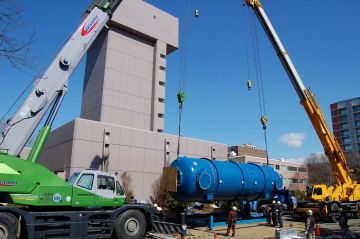
Main body of 6 MV tandem accelerator being brought into the University of Tsukuba (March 2014)
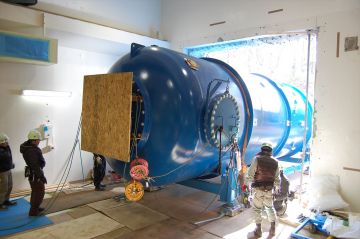
Since Prof. Sasa arrived at the University of Tsukuba in 1999, he has been engaged in accelerator maintenance and research using accelerators. The shutdown of the 12 MV tandem accelerator was naturally a shock to him, but he has been utilizing another small Tandetron accelerator (with an acceleration voltage of 1 million volts), and carrying out design development and preparations for adoption of the 6 MV tandem accelerator. The theme of his research in graduate school was inertial fusion using heavy ion beams generated by accelerators, and this mainly involved development of heavy ion accelerators. Since taking charge of the accelerators at the University of Tsukuba, he has promoted various joint research projects exploiting the characteristic that ion beams can be generated with highly precise acceleration voltages. Ion beams generated with an accelerator are directed into various measurement devices, depending on the application. Some of the most typical examples include: an accelerator mass spectrometer, microbeam generator, heavy ion nano-processing system, irradiation system for components used in space, micro-PIXE element analyzer, and ion beam analysis system. The irradiation system for components used in space enables testing of the cosmic ray resistance of devices installed in satellites. Prof. Sasa collaborates in research using these systems, and consults with other researchers about new research themes.
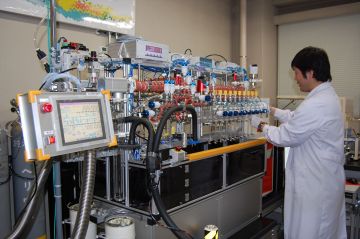
Fully-automated sample treatment system for carbon-14 dating located in the laboratory
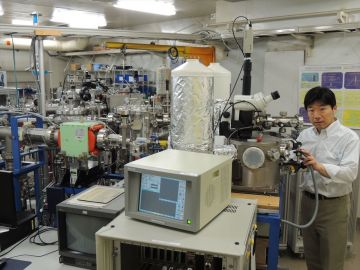
Prof. Sasa often develops his own equipment for use in research.The photo shows a jointly developed micro-PIXE element analyzer.
The University of Tsukuba's 6 MV tandem accelerator will be a powerful tool for accelerator mass spectrometry of long half-life radionuclides that can be found in extremely trace amounts. By investigating the trace radionuclides contained in various samples, it can elucidate facts about the past which cannot be discovered with any other method. Among the research projects Prof. Sasa has previously been involved in, he found particular significance in joint research which helped improve the method of estimating the exposure dose from the atomic bombing of Hiroshima. It had been determined that there were discrepancies between estimated and actually measured values with the past estimation method. Accurate measurement values were needed to confirm the precision of the new DS02 estimation method developed to address that problem. Prof. Sasa and his co-workers therefore used the accelerator mass spectrometry method to measure the amount of 36Cl, a long half-life (300,000 years) nuclide, produced by neutron beams from the atomic blast in granite obtained from sources such as the handrails of the Motoyasu Bridge next to the Atomic Bomb Dome, and the walls of the old Hiroshima City Hall. These survey results were used to verify the correct scale and hypocenter correction for the Hiroshima atomic bomb, and DS02 was adopted as a new method of estimating exposure dose. This all happened about 10 years ago.
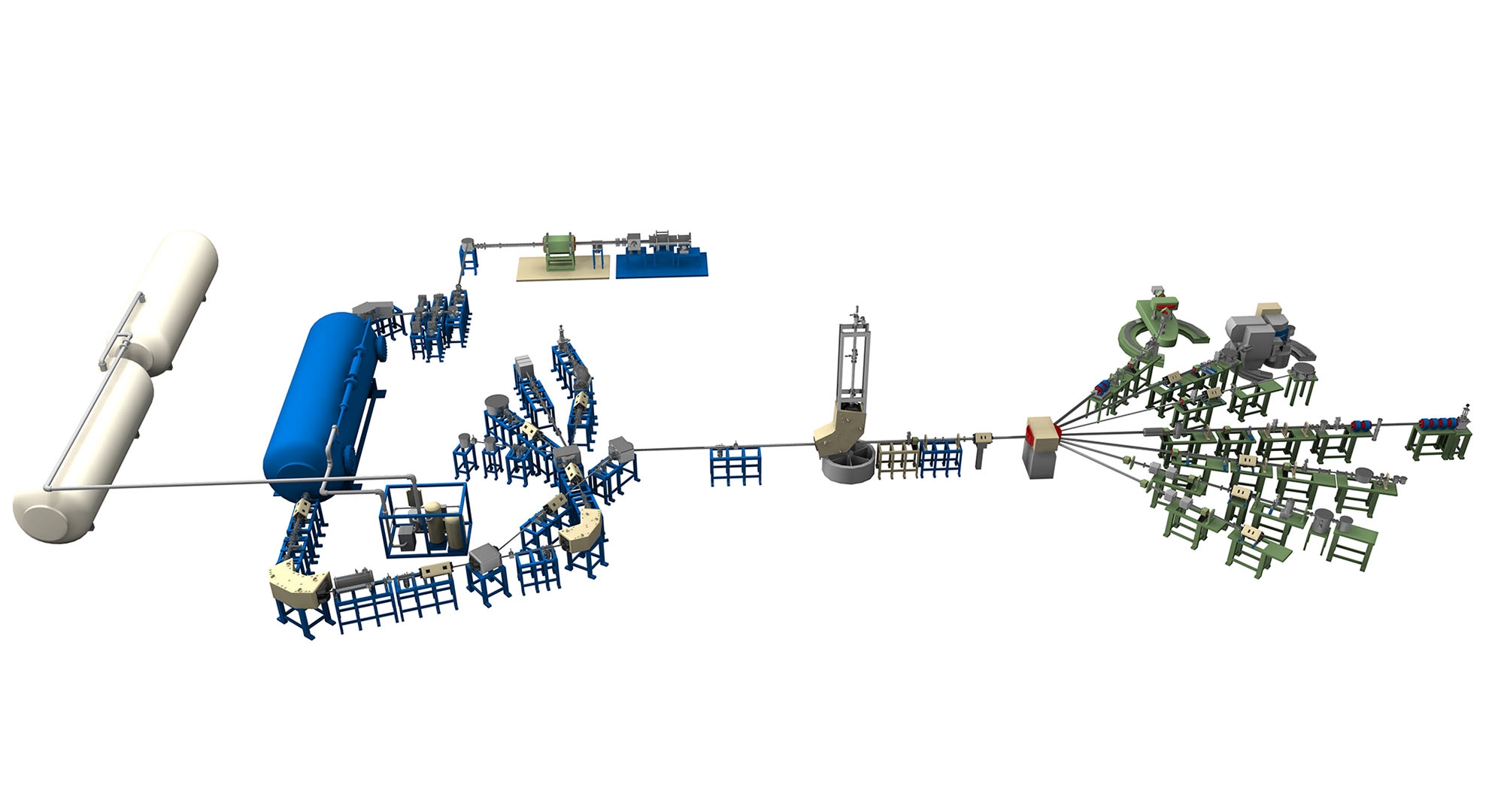
State-of-the-art 6 MV tandem accelerator system which will begin operation in fall 2014. It is equipped with 5 ion sources and 12 experiment beamlines. Width of the entire accelerator system is roughly 50 m.
Prof. Sasa is also investigating the accident at the Fukushima Daiichi Nuclear Power Plant. He began working on this immediately after the accident, and in the fall of 2011 his research team was the first to publish a radioactive material contamination map for the eastern Kanto region which covers Fukushima, Ibaraki, Tochigi and Chiba. His current aim is to reconstruct the initial amount of iodine-131 fallout (half-life: 8 days) released immediately after the accident. There are concerns about thyroid exposure to iodine-131, but the iodine from that time no longer exists and thus cannot be directly measured. Therefore his plan is to estimate the amount by measuring the iodine-129 (half-life: 15.7 million years) which was released at the same time. Since iodine-129 occurs only in trace amounts, it is difficult to measure with ordinary methods, and this is where accelerator mass spectrometry comes into play. Prof. Sasa's philosophy is to travel to actual sites, not just sit in the laboratory. He travels on his own to collect samples in the areas near the Fukushima Daiichi Power Plant.
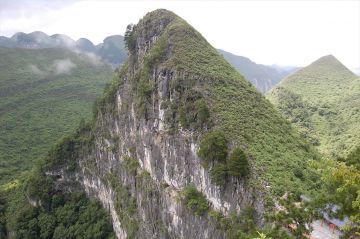
Prof. Sasa has also conducted research to estimate the formation age of large shafts in the Guangxi Zhuang Autonomous Region by measuring nuclides produced by cosmic rays in rocks. Thanks to his receptive approach toward joint research, he has opportunities to see the wonders of nature in remote regions.
He is also conducting some "research with a dream." For example, based on ice cores with a total length of 3,000 m taken from the Antarctic Dome Fuji Station and from Greenland, he is attempting to reconstruct variation in the global environment, solar activity and cosmic ray intensity over the past few hundred thousand years. Unfortunately he has duties maintaining accelerators, and thus cannot go on long trips to visit Antarctica and Greenland himself. He also consults with other researchers about dating of archaeological and cultural artifacts using carbon-14 dating. Prof. Sasa entered this field from accelerator development, and his current interest lies in how accelerators can be used to benefit society.
Article by Science Communicator at the Office of Public Relations


